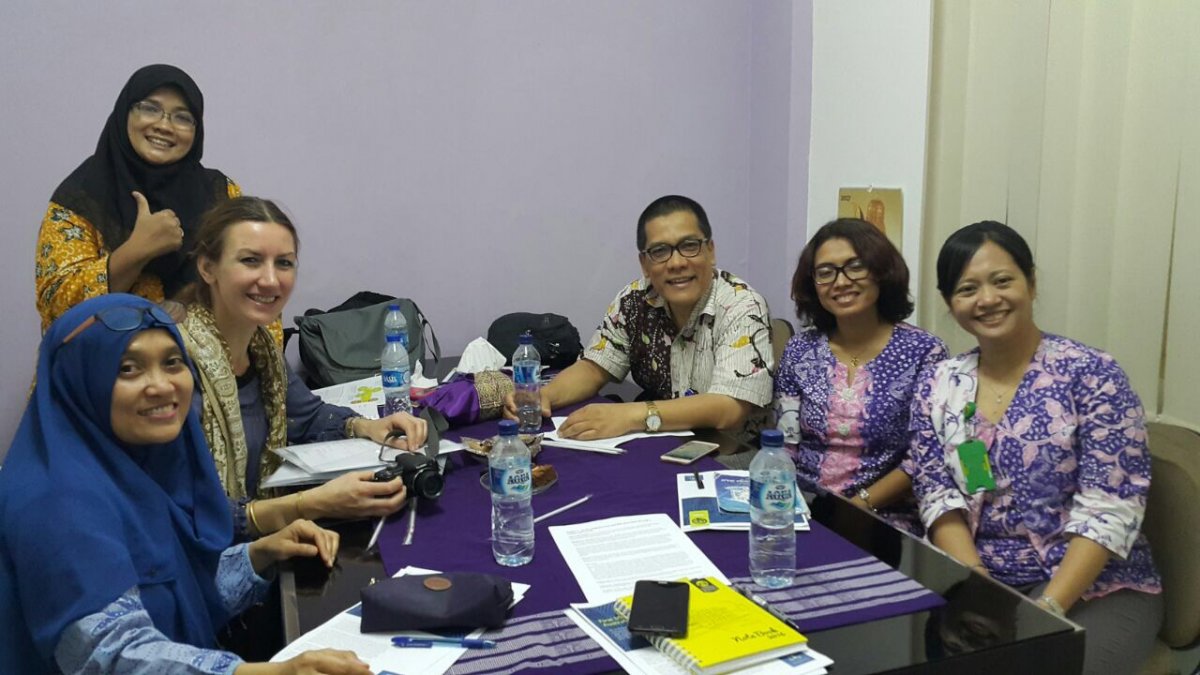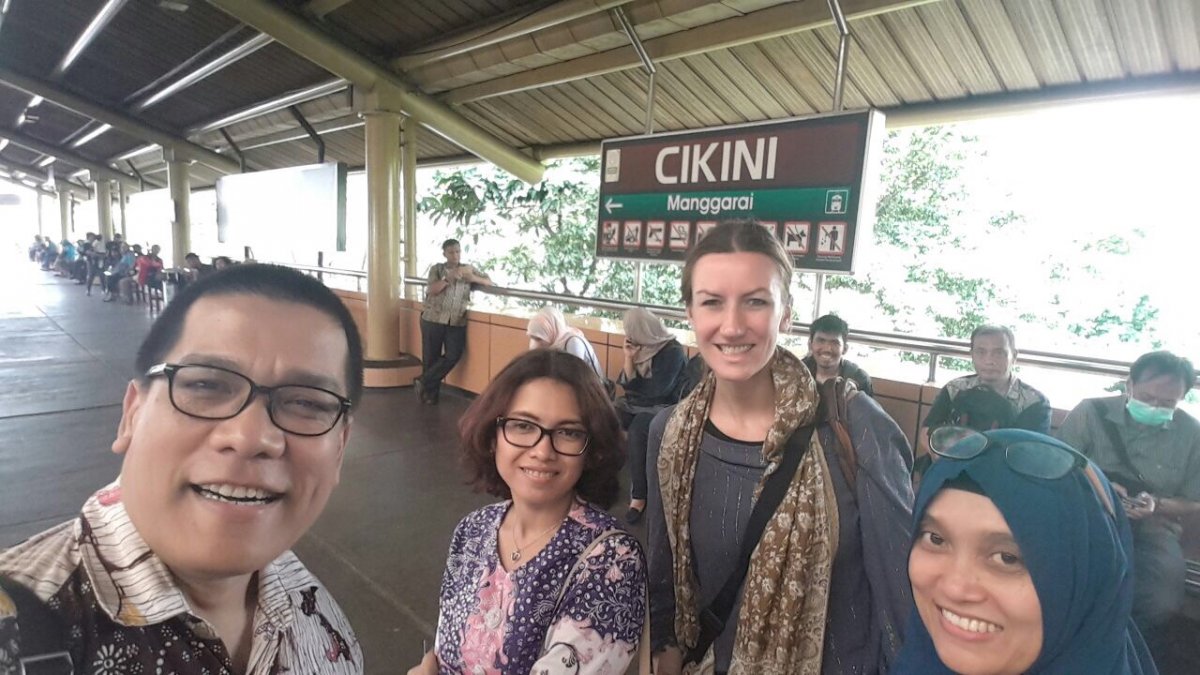By Kerry Arabena
This week, we have our staffers Elle and Endang in Indonesia working with local collaborators reviewing programs in the lead up to our Australian Indonesian Centre-funded roundtable discussion at the First 1000 Days Australia’s October Summit. They are also gaining material for courses offered through the University of Melbourne’s Master of Public Health program. Meanwhile, Research Fellow Rebecca is on holiday with her Oma in Germany, but snuck in a visit with data management experts to talk through how we might take our first 1000 days pre-conception household-level surveys to scale. These surveys focus on aspirations – particularly the aspirations parents have for themselves and for their children.
This strategy of purposefully shifting the public policy discourse from deficit to aspiration demonstrates the power of linguistic responsibility in action. It also means that the First 1000 Days Australia movement is ‘out of step’ with a lot of current government ‘deficit’ policy discourse, which has impacted our capacity to secure sustainability. This is ok by us; we know we are misaligned. But we also know how to change it and, in the words of Vincent Lingiari, ‘we know how to wait’. We know change is coming with calls for Treaty, Constitutional Recognition and reform coming loud and clear from #Garma2017. We also know we cannot have a change in policy, without a change in discourse.
This is where the First 1000 Days Australia movement can deliberately gain momentum for our families and children who are yet to be born. Part of our strategy for sharing the message of First 1000 Days Australia has been to talk at conferences, be on committees, try to influence policymakers, program implementers and community people through the short courses, and to draw together key concepts and ideas that have largely structured what we do and how we do it.
There have been three key influencers for this focus. The first is my own experience of writing grants while living in remote communities across Australia. The only way I could fund good health work to be done was to describe people living in the community as ‘deficit’ people living impoverished lives, whose vulnerability was much worse than those living in proximate communities. This did not sit easily with me, and I had the chance to write about why not when I was later situated in AIATSIS. The second is the PhD done by my friend Dr Rose Aldrich focusing on politics, discourse, policy and the health of Aboriginal and Torres Strait Islander people from 1972–2001, which shows how the language used by politicians to describe our people directly impacts on our health and wellbeing. She identified four pervasive policy discourses that frame our lives:
‘control and responsibility’
‘competency and capacity’
‘the problem’, (including causes and solutions)
‘the other’.
She also coined the phrase ‘policy imagination’ and identified differences in the ways in which social democratic and conservative administrations used their discursive frames, communicating values and beliefs about Aboriginal and Torres Strait Islander children. The third is the work of Dr Sana Nakata, a political theorist who writes about the politicisation and conceptualisation of children in policy processes, which has strong resonance with what we aim to do.
They are small things – but important things. The first we have done is to make the statement that positive early childhood outcomes start before children are conceived. We have been able to change the policy processes to recognise children from birth, to conception, then to pre-conception. We have also broadened out the First 1000 Days movement internationally to be inclusive of pre-conception, with our Council designing a Charter of Rights for children ‘yet to be conceived’ to guide the ways in which we consider pre-conception as vital to understanding early childhood, and the premise of our pre-conception household levelled surveys.
Secondly, we give people and children an experience and not an identity. Again, being mindful of the power of discourses to shape and influence how we live our lives, we avoid the language of vulnerable children or marginalised families. The use of these power-laden words as adjectives structures the ways in which we empower or disempower people in relation to our services, and how much control service providers and others have in assisting them to achieve their life goals. We have a multi-billion dollar industry that depends on us having these identities and, in doing so, commodifies us as a people. Instead, we use the terms ‘children experiencing vulnerability’, ‘families experiencing disadvantage’. We know all people experience these things across their lives, these are human experiences – we are, after all, human. We also know that most of our children live safely at home and have developed clear cultural identities linked to their community and culture, and that we have strong and rich cultural and community networks, spirituality and ways of raising children that encourage their development, resourcefulness and resilience. This is why we are so happy to see the Queensland Government adopt a strengths-based language and ‘language of experience’ rather than the ‘language of identity’ in its policies, and hope to see more of the same in other States and Territories.
Thirdly, we are very clear when we write research and other papers that we frame our work and our people in positive, validating and empowering ways. A recent compilation of papers in the Australian Journal of Primary Health, for example, described health promotion as a social purpose, as social justice and equity for all. To engage in health-promoting activities also requires us to write back against the deficit discourses that pervade public policy discourse, thereby changing the collective story of Aboriginal and Torres Strait Islander communities from one of deficit to one of strength and resilience. We would encourage other researchers to do the same.
Finally, we encourage other services, agencies and philanthropic organisations to change their funding parameters and come on a journey with people and organisations such as ours. We emphasise that the quality of the process will, in the end, determine the quality of the outcome. This is a big shift we know – particularly for those who are invested in outcomes or outputs – in having to talk publicly about our needs rather than our strengths, and who want to do things to us or for us but not with us. We are all locked into these pervasive public policy frames for now, and we are aware that there are large financial risks for those who might want to follow a change in public discourse, particularly if funding, for example, is dependent on the ‘needs or protection of Aboriginal and Torres Strait Islander children’.
Genuine engagement with Aboriginal and Torres Strait Islander people requires informed consent, and relationships built on trust and integrity, and within a frame of self-determination. The discourses we use in our work, how we secure sustainability and how we responsibly enact innovation need deliberation, conscious action and power sharing. Rather than focusing on ‘what services do you need’, maybe a good starting place is ‘how do you want to be described in the way we work with you?’ New language, new conversations, new paradigms. Let me show you what can be achieved.
In Brisbane 2016, at the Child Aware Conference, I presented on what Joanne Luke, a PhD student and epidemiologist at the Melbourne School of Population and Global Health, had found in the 2016 Prime Minister’s Closing the Gap Report. The report stated that the targets to Closing the Gap in childhood mortality were on track to close by 2018, but in one graph Joanne had drawn two lines showing that in fact the gap was widening (p. 5). The Closing the Gap in Indigenous Disadvantage Strategy in the Australian Government started in 2008, however, the trajectory for the graph includes information and evidence from 1998. This is significant, because most of the downward trend occurred during the period 1998–2005 when the policy discourse was framed around self- determination.
During this time, we had Homelands Movements, Bi-Lingual education, ATSIC Regional Council elections, the Deaths in Custody Report, and the National Aboriginal Health Strategy (1989) – all of which resulted in funding certainty to Aboriginal and Torres Strait Islander corporations. Two way-learning was paramount, indicating a preparedness to work side by side with people on issues of concern. We had land rights activism and, in the year 2000, we had the birth of Reconciliation Australia. From 2004 to 2007, the policy discourse was transformed: we had the abolition of ATSIC and the demise of regional councils, and we then had the NT Intervention – all premised on the ‘failed experiment’ of self-determination and the need to ‘mainstream’ services because of the problem of Aboriginal health disadvantage.
The health and wellbeing trajectory for childhood mortality started to plateau, and continued to stay the same between 2008 and 2014. During this time, we have been in a policy discourse shaped strongly by the ideas of ‘competency and capacity’, ‘the other’ and ‘the problem’. These discourses have facilitated the changes in procurement laws that saw:
large non-government agencies able to compete with Indigenous organisations to deliver services to our communities
the establishment of the National Congress of Australia’s First Peoples’ but an unwillingness to fund it beyond its first tenure
the commencement of the Recognise Campaign and calls for Constitutional reform amid growing concerns about racism
more of our children in care
less Aboriginal and Torres Strait Islander people employed in high-level decision-making positions in the Australian Public Service
overt rationalisation used as a way of cutting more than $500 million from the Indigenous Affairs budget to support programs delivered through community controlled organisations
the delivery of Andrew Forrest’s report as a hallmark policy initiative whereby a high net worth individual was able to determine Indigenous Affairs policy.
Without a doubt, the language used in public discourses has absolutely shaped the outcomes for our children.
Showing that graph by Joanne, along with the transformations in public policy discourse and the direct impact on childhood mortality at the 2016 conference and to other audiences across Australia, focusing on the period of time from preconception to age 2, has however led to a policy impact. In this year’s Prime Minister’s Report on Closing the Gap, the PM’s Introduction included recognition of pre-conception and the early years through to school (p. 4), and also acknowledged that the target to halve the gap in child mortality by 2018 is not on track this year (p. 6). When I read this, it felt like a ‘close the door and do a little dance around the office’ kind of moment.
I have learned over the years though that the quality of funding does not determine the quality of impact. In fact, not being funded until recently has allowed the idea of First 1000 Days Australia to grow and evolve, and for innovation, entrepreneurial spirit and creativity to be at its core. We encourage each one of you to watch your words, and to use them well. They are so powerful, they literally have a life and death impact on us.
I long for the day when I do not have to sell a deficit story about our children, or their parents, to get funding. It degrades us all. Hopefully, and soon, we will not have to. This misalignment between policy imagination, policy discourse and our aspirations for a better brighter future for all Australians is ripe for transformation. Join with us in being linguistically responsible, and know we support you.
In unity, Kerry Arabena



